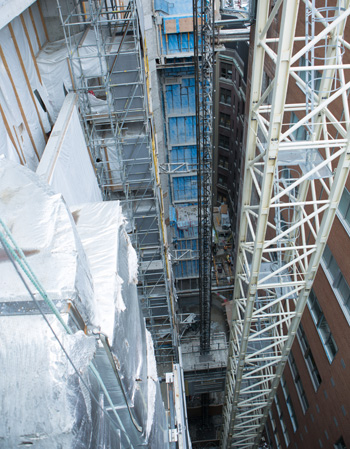Planning makes perfect in stairwell demolition project

By Kate Manicom

A view from the hospital’s 11th floor, the blue strip indicating where
the Cardinal Carter South stairwell previously stood.
(Photo by Katie Cooper)
More than one year ago, planning started for the demolition
of the Cardinal Carter South stairwell. The 17-storey
structure stood in the way of linking the new Peter Gilgan
Patient Care Tower to the existing hospital.
After seven months of demolition that dismantled 410 stairs
and 2,317 cubic metres of concrete, the project is complete.
“The stairwell had to come down so that we could finish
building something great,” said Michael Keen, senior director
of Planning and Redevelopment. “We knew the work would
be noisy and could potentially generate vibrations. We
planned the project with safety and patient care as our top
priorities, and as a result of collaboration within the hospital
and with our external construction partners, we succeeded
in completing the project safely, with minimal impacts to
patients and their loved ones.”
In June 2016, the hospital’s Department of Operational
Readiness initiated planning with teams across the
hospital. Operational Readiness’s role is to ensure that each
patient has the right care, in the right space with the right
equipment and technology, at the right time, regardless of
construction activities in the hospital.
Because the stairwell was built adjacent to critical patient
care areas, including the Medical-Surgical Intensive
Care Unit, the perioperative floor and medical imaging,
mitigation plans were established in case noise levels or
vibrations were unsafe or affected patient care. Vibration
monitors were placed throughout the hospital, and protocols
were developed to monitor equipment, infection prevention
and control, and patient and staff safety. The hospital also
acquired ear plugs and ear muffs for patients in areas close
to the demolition.
The Planning and Redevelopment team worked closely
with the project’s contractor to find alternate demolition
methods. To reduce noise and vibrations, the contractor
saw-cut the staircase from the existing structure, crushed
the slabs into smaller pieces, then removed them from the
site using a tower crane.
“As a result of collaboration within the hospital and with our external construction partners, we succeeded in completing the project safely, with minimal impacts to patients and their loved ones.” – Michael Keen, senior director, Planning and Redevelopment |
Once demolition started in early 2017, an operations centre
was established that met twice daily to monitor progress
and resolve issues quickly. Program directors and the
director of hospital operations submitted daily reports to
inform the operations centre of any construction issues, noise
or vibrations. Over the course of demolition, the operations
centre committee held 198 meetings.
The hospital’s complex clinical environment also required the
contractor to work flexible hours.
“While demolition was adjacent to the hospital’s operating
rooms, there were some challenges in managing busy periods
in the operating rooms and demolition schedules,” said
Catherine Hogan, program director for Perioperative Services.
“The contractor worked with us to change their schedules
and enable safe patient care.”
With the stairwell demolition complete, the hospital is
looking to its next demolition project: the Shuter Wing will
come down in 2018 as part of the expansion of the new
Slaight Family Emergency Department.
About St. Michael’s Hospital
St. Michael’s Hospital provides compassionate care to all who enter its doors. The hospital also provides outstanding medical education to future health care professionals in more than 29 academic disciplines. Critical care and trauma, heart disease, neurosurgery, diabetes, cancer care, care of the homeless and global health are among the Hospital’s recognized areas of expertise. Through the Keenan Research Centre and the Li Ka Shing International Healthcare Education Centre, which make up the Li Ka Shing Knowledge Institute, research and education at St. Michael’s Hospital are recognized and make an impact around the world. Founded in 1892, the hospital is fully affiliated with the University of Toronto.
